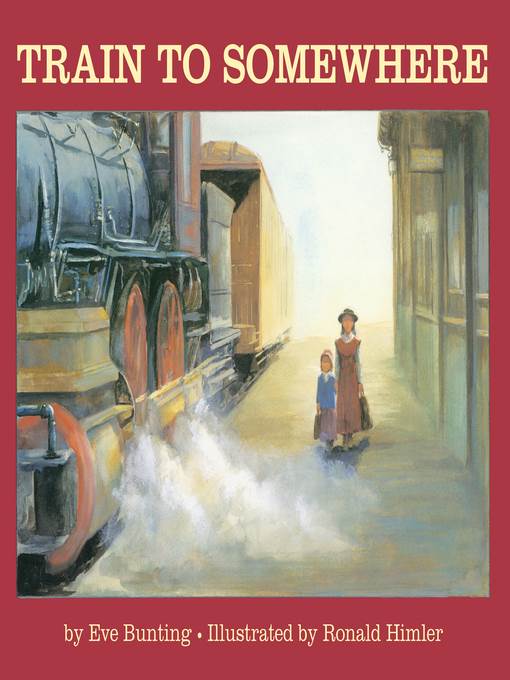
Train to Somewhere
فرمت کتاب
ebook
تاریخ انتشار
2000
Lexile Score
610
Reading Level
0-2
ATOS
2.8
Interest Level
K-3(LG)
نویسنده
Ronald Himlerناشر
HMH Booksشابک
9780547772684
کتاب های مرتبط
- اطلاعات
- نقد و بررسی
- دیدگاه کاربران
نقد و بررسی

Starred review from January 29, 1996
Inspired by a little-known chapter of American history, this characteristically incisive collaboration from Bunting and Himler (Someday a Tree, see p. 90; Fly Away Home) imagines a journey on one of the many "Orphan Trains" that, between the mid-1850s and the late 1920s, brought children from New York City orphanages to adoptive families in the West. The narrator of this finely crafted, heart-wrenching story is Marianne, a plain girl secretly dreaming of being reunited with her own mother, who promised to return for Marianne after making a new life for them in the West. Bunting ably weaves the girl's hopes and anxieties into her perceptive account of how each of Marianne's 13 companions is chosen for adoption at the various train stations while she futilely searches the crowd for her mother. Finally only Marianne remains. In the tale's optimistic ending, Marianne finds a new family in Somewhere, Iowa, the train's last stop. Here an elderly couple, who clearly had planned on adopting a boy, take Marianne in, with ultimately comforting, resonant words: "Sometimes what you get turns out to be better than what you wanted in the first place." Himler's watercolor and gouache paintings offer polished portraits of the period as they convey the plot's considerable emotion. Like Bunting's text, his art is at once sobering and uplifting-and assuredly memorable. Ages 5-8.

Starred review from March 1, 1996
Gr 2-4-From the mid-19th century until after World War I, thousands of homeless "orphans" were sent West by charitable agencies to find homes with families seeking workers, children to adopt, or mother's helpers. In telling the story of one child, Bunting encapsulates the fears and sometimes happy endings of those fateful trips. Marianne is among the oldest and least attractive of the 14 children sent on a train to the Midwest, and she starts the journey with hopes that her mother will be waiting at one of the stops. At each station, papers are signed and children are placed, until only Marianne remains when the last town of Somewhere is reached. Only an elderly couple, hoping for a boy, is waiting there. They look kindly at Marianne, and the grandmotherly wife sums up the story's theme when she remarks that "Sometimes what you get turns out to be better than what you wanted in the first place." By making this slice of American history into an appealing tale, Bunting offers an opportunity to compare present-day social policies with those of times past. The book is timely yet universal in showing the desire of every child for a loving family. Himler's full-page, bordered paintings portray the people and towns in warm colors and softly blended brush strokes. Beyond this gentle story lie the social issues of our own day.-Shirley Wilton, Ocean County College, Toms River, NJ

Starred review from February 1, 1996
Gr. 2^-5. Another heartbreaking picture book by the pair who did "The Wall "(1990) and "Fly Away Home" (1991). This time, it's the story of the Orphan Train, told in the voice of one girl. Marianne is in a group of 14 homeless children traveling with a guardian from New York to the Midwest in 1878 in search of families to adopt them. The words and pictures are understated; readers will fill in the spaces for themselves. "I'm not pretty," Marianne tells us. She's the one nobody wants. She's older than the others, not as cute as the little girls, not as muscular as the boys, not manipulative. The train stops at small towns and railway sidings; the orphans try to smile and look their best; it's like an auction. The townspeople look them over ("They feel the boys' muscles through their coats" ). It's clear that some children will find loving homes; some will not. Marianne tries to tell herself that her mother is waiting for her somewhere out West. Himler's paintings in watercolor and gouache set the story against a bleak midwestern fall landscape. Occasional small pictures show the train steaming across the prairie. The group scenes of the children lined up for inspection evoke images of stiff family photos. Then, as the numbers dwindle, the focus is on individual faces staring ahead as their companions are embraced and adopted. The guardian is gentle--in one beautiful picture she combs Marianne's hair to prepare her for the last train stop--and the quiet ending is hopeful. Marianne is taken, finally, by an elderly couple. They really wanted a boy, but they like her, and they're kind. Even older students will find the history compelling and will want to find out more about what happened to those lonely children. ((Reviewed Feb. 1, 1996))(Reprinted with permission of Booklist, copyright 1996, American Library Association.)

























دیدگاه کاربران